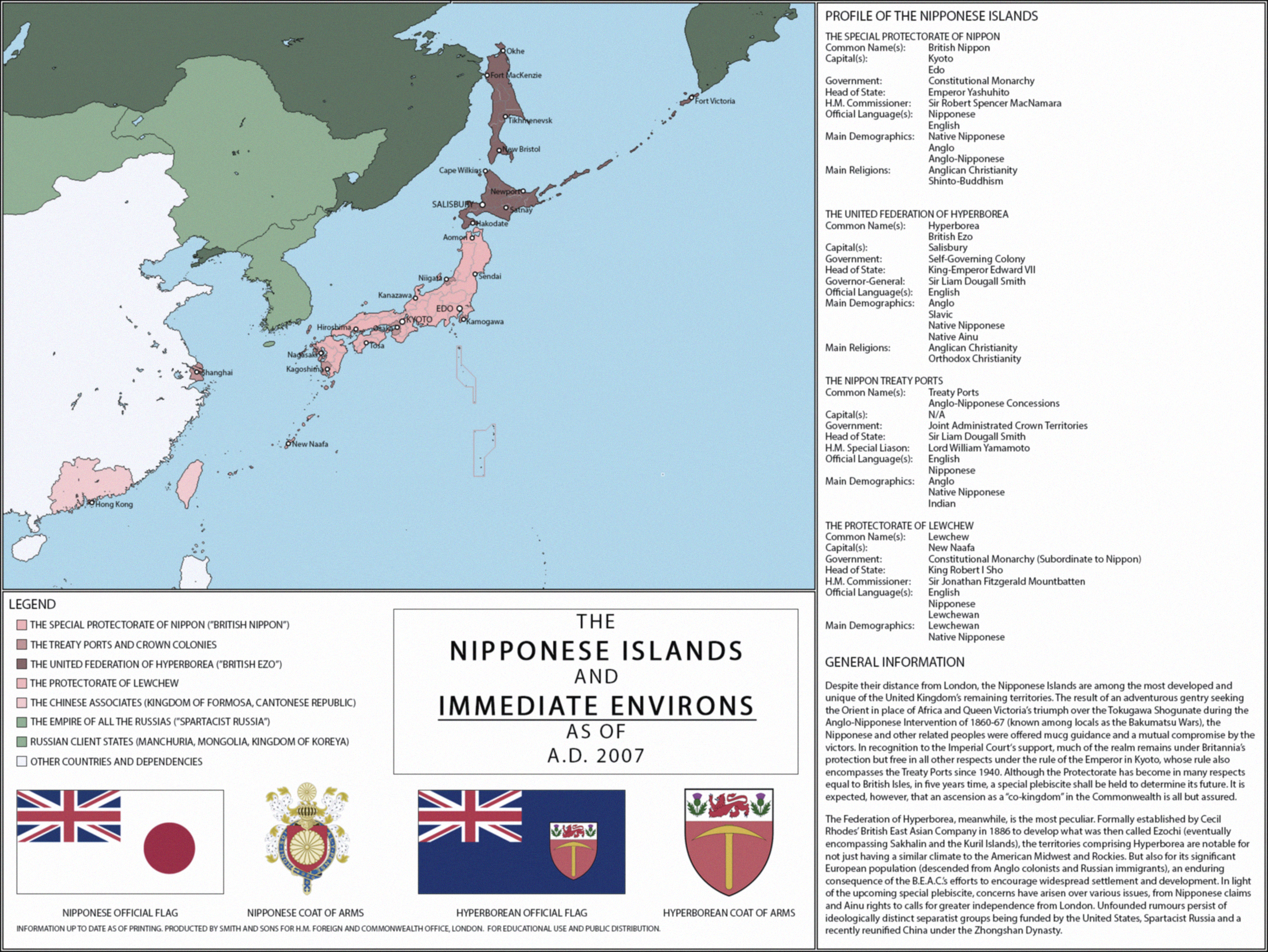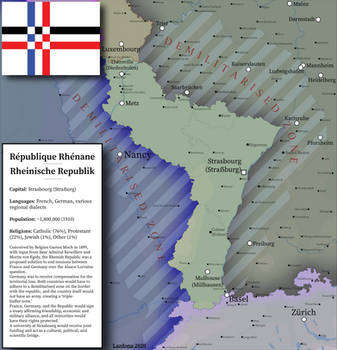ShopDreamUp AI ArtDreamUp
Deviation Actions
Description
Here's the first new proper map-profile I've done in a bit. This one though is something rather different: as it's a combination of two seemingly disparate ideas involving Japan.
On the one hand, it's based on the idea of what would happen had the British Empire not only paid more attention to the Far East by the 1850s. But were also in a stronger position of effectively seize Japan during the infamous Bakumatsu period that in our timeline led to the Meiji Restoration. Admittedly, it's partily inspired by certain mods for Total War: Shogun 2: Fall of the Samurai and the experiences of India's Princely States, as well as more than a few Paradox games. On the other hand, it also a look into just how different the fate of Hokkaido, Japan's "frontier" and home of the Ainu minority, would have been had others gotten to settling/colonizing/developing it (and by extension, Sakhalin and the Kurils) first. In this case, it's the British and more specifically Cecil Rhodes, as it'd be interesting to see how a colonial venture like Rhodesia (modern Zimbabwe) would play out had it been in that corner of the Far East.
Just to be on the safe side, this is not a political piece or propaganda spiel, nor intended to be in any shape or form racist. This is a work of fiction.
That being said, I hope you like this!
(EDIT: Fixed some typos in the text.)
(EDIT: Fixed some typos in the text.)
----
The Mid-19th Century A.D. was a time of great change. An age of industrialization and imperialism, of turmoil and glory. For the British Empire, though, it also marked the dawn of a new chapter in the Realm's history, involving the unlikeliest of places: the Nipponese Islands. Some would say that this story began with the growing focus on the Orient in the wake of the Opium War waged against the decaying Qing Dynasty in the 1830s, setting the stage for the founding of Hong Kong and the eventual Chinese Associates. Others still would contend that it was either a desire to contain Russian (later on, American) designs in the Pacific or the Cape Colony's authorities preferring to leave both the Bantu peoples and so-called Boers alone.
Whatever the case, British influence in the Pacific had grown considerably by 1850. In the wake of U.S. Commodore Perry's infamous visit to Nippon three years later, Queen Victoria saw an opportunity in being among the first to "open up" the isolationist islands before the other Great Powers could. Before long, adventurers, merchants and aspiring tycoons from as far as England itself were establishing ties with the Nipponese while diplomats in London offered "treaties" that benefited the Empire where the Sun Never Sets; not only were a handful of "Treaty Ports" secured, but so were the Ryukyu Islands, soon known as the Lewchew Protectorate (which would be handed over to Nippon). Many, especially those loyal to the increasingly chaotic Tokugawa Shogunate, however, quickly grew resentful what was seen at the time as subservience to "foreign barbarians." But though others were content with simply swaying this or that clan or playing off various samurai against each other, Britannia had a much larger prize in mind. Following the massacre of a Scottish delegation in Osaka in 1860, Parliament formally passed a declaration of war against the Shogun.
While having the support of some of the more dissident southern clans like the Shimazu of Satsuma Domain, the initial British expedition was a hapharzard collection mainly comprised of Indian and Anglo regiments from the Raj, along with a handful of Royal Marines; in the aftermath of the Sepoy Uprising of 1857 and subsequent dissolution of the East India Company, many former "company-men" were quick to accept military commissions. But even such a ragtag force proved more than capable in holding their own against the martial prowess and fierce Bushido valour of their foes, even as the latter increasingly turned to using modern firearms in place of their ancient swords. Eventually, reinforcements from Australia, Canada and even the British Isles trickled in, soon turning the tide against the Shogunate and those who dared oppose Her Majesty's soldiers; this would culminate in the Battle of Edo in 1867, which finally broke the Tokugawas at the cost of many lives on both sides. It would be the so-called Kyoto Compromise that same year, however, that would finally end the Bakumatsu Wars (also known as the Anglo-Nipponese Intervention) by gaining the full support of the Imperial House of Yamato and its supporters, who quietly sided with them up until that point. Emperor Mutsuhito, known to history as Meiji, was soon recognized as his country's sovereign monarch "by the Grace of Amaterasu," his people promised the right to self-rule and manage its own affairs. In exchange, however, the "Treaty Ports" secured during the conflict would remain under direct British rule, while the rest of Nippon became part of the British Empire as a "Special Protectorate" (the first and only one of its kind), with an acting Commissioner acting as something between a governor and advisor to the Emperor. To the surprise of the defeated, though, the victors proved to be as merciful as they were formidable. Many Nipponese were quick to learn from their new benefactors, modernizing in a few decades what would have taken centuries. By the 1900s, they had even begun to resemble more of an European state than an Oriental one, adopting many Western fashions, trends and technologies while still retaining much of their storied heritage.
The island of Ezochi was another matter. Although the Tokugawas, through the Matsumae Clan, treated it as aborder march and a sliver of Nipponese settlements existed along the southmost portions, it was by and large an untamed land where the mysterious Ainu people lived. While the British initially sought to secure the island as a strategic outpost and native reserve, surveys conducted over the 1870s also found the area to be suitable for settlement and ripe with resources. These proved to be more than enough for rising magnate Cecil Rhodes, who found himself increasingly attracted to the Orient over Africa. Using his existing investments and South African connections, he gained concessions from the Colonial Office in London as well as local Ainu chieftains, his "British East Asian Company" (which also inherited his private security force) granted a Royal Charter by 1885. Hoping to establish a "proper" counterbalance to both the Slavic and Nipponese peoples, he organized a group of Anglo pioneers comprised of settlers and B.E.A.C. volunteers, who founded Fort Salisbury over an abandoned village in 1886; this also marked the formal establishment of the Colony of Hyperborea, which name had been chosen to placate those suspicious of Rhodes' motives. Through shrewd cunning, backroom deals and the British East Asian Police (along with Royal Navy protection), Hypberborea's territory encompassed the sparsely populated Sakhalin and Kuril islands (as Russian control remained weak there) by 1894, with incentives to attract more colonists bearing more fruit, with agriculture and mining proving to be successful ventures. The European population grew even further (including, ironically the first wave of Russian immigrants) with the discovery of gold, soon rendering any tensions with the Ainu moot. Barring some early conflicts and standoffs, what had until then been a backwater into a bustling land of opportunity, where a man could shape the future with his hands.
Generations have passed since then.
By 2007, 140 years after the end of the Bakumatsu Wars, British Nippon is among the most prosperous domains in the Commonwealth and remains the most peculiar of the U.K.'s remaining territories. While still a "Special Protectorate," in more ways than one the Nipponese are equal to the British Isles in terms of influence, political clout and prominence. Having gained even greater autonomy in the intervening years in spite of the Great Wars (which brought down Qing China and forged Spartacism, among others), cities like Kyoto and Edo are major political and economic hubs, while the "Treaty Ports" (under joint administration since 1940) remain a showcase of blending Anglo-Nipponese culture. This extends to the hybrid culture that has emerged among Nipponese at large, with many adopting Western first names, Anglo dress, Anglicanism (though often at friendly rivalry with the still influential Shinto and Buddhist temples) and even mixed-race unions, but still holding to their curious language and storied, living past. The passing of time has also not just dulled any lingering resentments against their British peers but has also made these two seemingly disparate lands even closer than ever. It's not for nothing that many of the old samurai clans had evolved into new noble houses and Knightly Orders. Or that any reasonable projection for the 2012 Special Plebiscite points to the country becoming a genuine "Co-Kingdom," which can potentially change the course of Britannia's future in the 21st Century.
Meanwhile, Rhodes' vision of an "Anglo-Saxon" alternative to Nippon hasn't been entirely successful, as a sizable portion of the "Settler" population is of Russian descent, some descended from those fleeing the rise of Spartacism in the 1930s. The Federation of Hyperborea, however, nonetheless remains very prosperous Self-Governing Colony, with a majority European and Anglicized populace. Agriculture and mining remain major industries, hosting a number of fairly prominent companies and exporting considerable amounts of food and wines. The British East Asian Police has since become the foundation for the Royal Hyperborian Security Forces, whose regiments have fought through thick and thin and keeping the Spartacists from coming in, for their children's children too. But all isn't as well beneath the surface. Regardless of the 2012 Special Plebiscite results elsewhere in Nippon, there has been greater clamor for autonomy, Dominion status and even outright independence from London; such sentiments have also been expressed in one way or another by the Smith family, who have held the Governor-Generalship for the past few generations. Meanwhile, although the remaining Ainu have equal rights and treatment before the law, resentments among more radical groups continue to sour relations between them and the "Settlers," to say nothing of the tensions amongst themselves, with some seeing more "loyalist" Ainu as traitors. Then there are the rumours that the Americans (hoping to sway public opinion away from the British), Spartacist Russians (still nominally under the Romanov Tsars) and the recently reunified Chinese (under the Zhongshan Dynasty, named ironically after the founder of Chinese Republicanism) have gotten involved with playing various internal factions against each other. Which may or may not have anything to do with a new gold rush related to Hyperborea's more lax banking laws.
All the same, these are interesting times. Especially for anyone deemed, in Ainu parlance, to have strong kamuy.
----
As a bit of trivia:
The Coat of Arms for the Nipponese is derived from the actual Coat of Arms of the Japanese Emperor as a Stranger Knight in the Order of the Garter.
The Hyperborean Coat of Arms, meanwhile is derived from that of Southern Rhodesia and the Republic of Rhodesia, only with a red hued background derived from the real life flag of Hokkaido Prefecture.
Also, Lewchew is an older English term for the Ryukyu Islands.
And yes, the title and gold rush references are both a nod to the Hokkaido gold rush in real life and the manga/anime series Golden Kamuy. Kamuy being an Ainu term for a supernatural/spiritual entity.
Image size
2214x1662px 5.67 MB
© 2018 - 2024 mdc01957
Comments9
Join the community to add your comment. Already a deviant? Log In
OwO wats dis!?
Very, very, very nice work, Migs!
Very, very, very nice work, Migs!


































